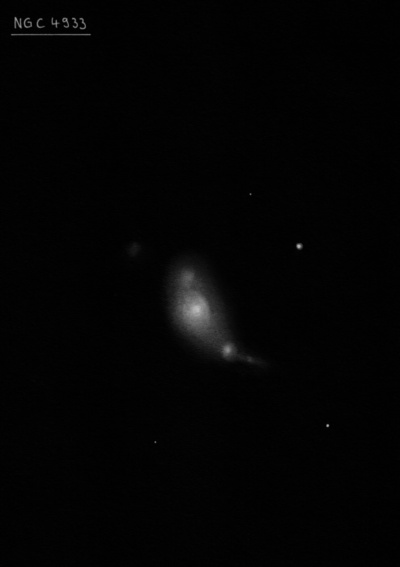
William Herschel discovered NGC 4933 = H II-191 on 9 May 1784 (sweep 210) and recorded "pF, pS, R, r. Near some small stars. Too much daylight to describe it fully." CH's reduced position is ~9 sec of RA west of this double system. In his fifth discovery paper, Wilhelm Tempel remarked that GC 3377 [NGC 4933] was certainly double, with a bright northeast component and a fainter stellar nebula on the southern edge, with a separation of 1'.
On 16 Apr 1895, Bigourdan claimed he searched unsuccessfully for NGC 4933, but reported finding Big. 315 = IC 4173 and Big. 316 = IC 4176, which he noted were in PA 225° (SW-NE) and a separation of 1'. His positions are wrong (over 2 min of RA too far east) as he misidentified his offset star, but once corrected they match the two components (nuclei) of NGC 4933! These IC identifications were resolved in an e-mail correspondence between Malcolm Thomson and Harold Corwin in April 1998. The RC3 labels IC 4173 = NGC 4933A and IC 4176 = NGC 4933B, with the two components first resolved by Tempel. NGC 4933C was not discovered visually.
400/500mm - 17.5" (5/17/90): moderately bright, moderately large, dominated by a bright core, faint extensions 2:1 SW-NE. Forms a contact pair with IC 4173 at the west edge in a common halo (Arp 176). IC 4173 appeared very faint, extremely small, round. Located 7.1' NE of mag 7.5 SAO 157687.
900/1200mm - 48" (4/21/17): NGC 4933 is a double system consisting of compact NGC 4933A = IC 4173 on the southwest side and NGC 4933B = IC 4176 on the northeast end, separated by 45" between centers. At 488x, NGC 4933B appeared bright, moderately large, elongated 4:3 or 3:2 SW-NE, ~1.0'x0.7'. Sharply concentrated with an intensely bright nucleus. The north side has a sharper light cut off [due to dust]. Located 7' NE of mag 7.9 HD 113425.
NGC 4933A on the southwest end appeared bright, fairly small, round, 15" diameter. Strongly concentrated with a very small bright nucleus and thin halo. A tidal tail extension (either from NGC 4933A or 4933B) juts out towards the southwest an additional 20". The combined glow of A and B extends at least 1.5' SW-NE. NGC 4933C = PGC 45143, a third component 1' NE of 4933B, appeared very faint, small, round, ~15" diameter, very low surface brightness.
Notes by Steve Gottlieb